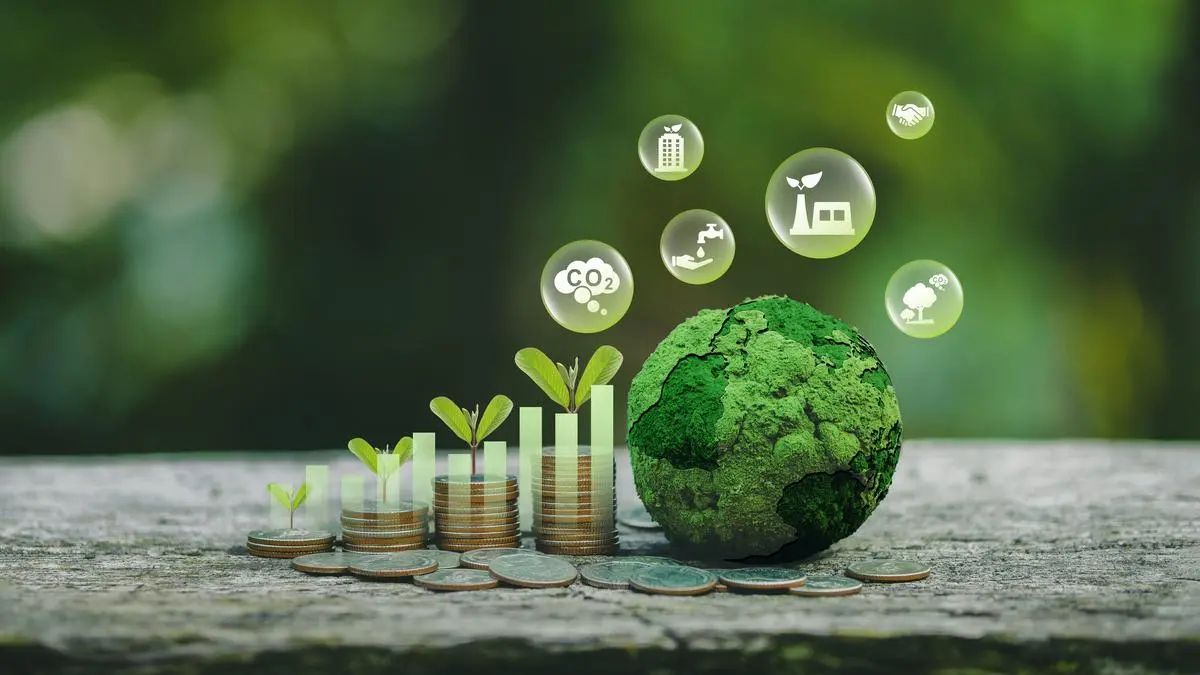By Sunil Kumar Sinha
Copyright thehindubusinessline

India’s climate actions so far have primarily been financed from domestic resources. These include government budgetary support, a mix of market mechanisms, fiscal instruments and policy interventions. India’s initial Nationally Determined Contribution (NDC) under the Paris Agreement estimated that the country’s climate action would require $2.5 trillion (at 2014-15 prices) for meeting India’s climate change actions between 2015 and 2030 which aims to reduce emissions intensity of its GDP by 45 per cent by 2030 from 2005 level.
In November 2022, India submitted its Long-Term Low-Carbon Development Strategy to the United Nations Framework Convention on Climate Change (UNFCCC). There are several estimates regarding India’s financial needs for Long-Term Low-Carbon Development Strategy action and they vary due to differences in assumptions, coverage, and modelling approaches.
But the estimated requirements show it will be in excess of $10 trillion by 2050. Given India’s financial needs for climate action, tapping the global sustainable/green finance and foreign private capital is expected to play a crucial role in achieving NDC goals.
The size of global sustainable/green debt finance has also been growing rapidly in response to the challenges of climate change. According to Institute of International Finance (IIF) data, the cumulative global sustainable/green debt issuances since March 2013 onwards reached $8.86 trillion in December 2024 (up from $1.5 trillion till June 2019). Of these mature economies accounted for $6.05 trillion (68.25 per cent), emerging economies $1.53 trillion (17.25 per cent), offshore centres $0.30 trillion (3.38 per cent) and supranationals $0.98 trillion (11.12 per cent).
Green instruments
The debt instruments used for raising sustainable/green finance range from green bonds/loans, green asset-backed securities (ABS), sustainability bonds, social bonds, green municipal bonds and sustainability linked bonds/loans. Of these green bonds account for the largest share of 37.10 per cent followed by sustainability linked loans (18.95 per cent), sustainability bonds (13.14 per cent) and green loans (10.44 per cent).
At $91.2 billion, India’s share in global sustainable/green debt issuances till December 2024 was just 1.03 per cent. However, when calculated as share in the sustainable/green debt issuances of emerging economies it looks more respectable at 5.97 per cent. At $690.7 billion, China’s share in sustainable/green debt issuances of global and emerging economies though is much higher at 7.80 per cent and 45.21 per cent respectively. Clearly India has a lot of catching up to do to increase its share in global sustainable/green debt issuances.
A number of measures for climate actions were announced in the Union Budget 2022-23, including sovereign green bonds and thematic funds for blended finance. India joined the sovereign green bonds club on January 25, 2023 by raising ₹80 billion.
Since then, a few more sovereign green bond issuances have taken place. Although the Securities and Exchange Board of India (SEBI) issued the ‘Disclosure Requirements for Issuance and Listing of Green Debt Securities’ in 2017, corporate entity in India had entered the green bonds market with Yes Bank issuing the first green bond of $260 million in 2015. Various public and private sector corporate entities have since then raised ₹76.53 billion via green bonds issuances till June 2025.
No doubt, India has been gaining traction in terms of accessing sustainable/green financing both locally as well as globally, yet the financing gap to meet its NDCs under UNFCCC remains huge. To bridge this gap, India needs to access the rapidly growing pool of global sustainable/green capital from pension funds, sovereign wealth funds, insurance funds, private equity, venture capital, infrastructure funds etc.
Policy enablers
The key to attract global private finance into sustainable/green projects in India is to focus on both micro and macro level policy enablers. At the micro level increasing the transparency by aligning the disclosure/reporting standards to global benchmarks will reduce the information asymmetry faced by investors/lenders. Further putting in place an integrated domestic measurement, reporting, and verification system would increase the availability and accessibility of sustainable/green finance data.
Similarly, at the macro level moving towards green taxonomy coupled with fiscal incentives and a credible domestic capital market will be crucial for accelerating the inflow of global private green finance/capital into India.
In this regard, Business Responsibility and Sustainability Reporting (BRSR) being made mandatory for the top 1000 listed companies in India and the announcement to develop a taxonomy for climate finance in the Union Budget 2024-25 are steps in the right direction, but much more needs to be done to attract global sustainable/green finance into India.
For example, developing a dedicated channel for the listing of green bonds at India’s stock exchanges could be one. Launching/expanding ESG performance-based equity/bond index on Indian stock exchanges and collaborating with offshore stock exchanges/index providers for inclusion of Indian green bonds into global indices could be another one.
The writer is Professor at Institute of Development and Communications (IDC), Chandigarh. Views expressed are personal
Published on September 18, 2025



